In today's designer-driven world of eyeglass frames, it's difficult to believe they were ever considered unfashionable. Not too long ago, however, an eyeglass prescription was a social death sentence. Due to a variety of social stereotypes and folklore, people thought they could immediately tell something about someone wearing glasses, and none of it was particularly socially desirable. This was likely because of the higher literacy amongst religious leaders of the day. Many of the earliest eyeglass wearers were clergymen, leading to the stereotype of glasses wearers as morally upright but socially withdrawn; the most common reason for needing glasses was presbyopia, leading to the stereotype of glasses wearers as old. It was believed individuals could ruin their eyes through excessive reading, leading to the stereotype of glasses wearers as physically weak. Moving into the 20th century, it appeared as though glasses would hold a place alongside crutches and dentures as medical requirements that forever burdened their users with undesirable looks in public and dateless Friday nights.
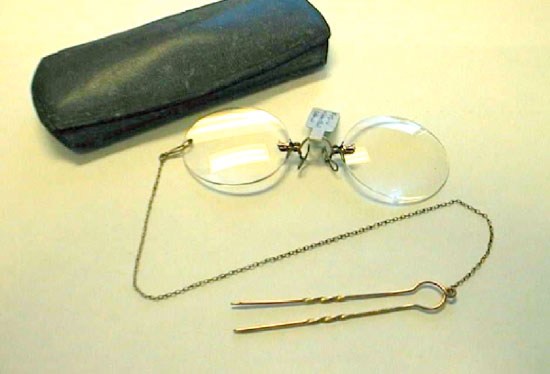
|
During the pince-nez craze of the late 1800s and early 1900s, numerous styles of pince-nez became available to the public. Most variations involved how the glasses attached to the nose. However, one unique design involved completely removing frames from around the lenses and mounting them directly to the apparatus which held them in place on the wearer's bridge. This "rimless" pince-nez became the ultimate non-fashion fashion statement, the most assured way of downplaying the presence of glasses on one's face. The style was seized upon by individuals from across the socio-economic spectrum, from teachers to bankers to the President of the United States.
To look at him today, few would believe that, in his time, Theodore Roosevelt was Arnold Schwarzenegger, Michael Jordan, and JFK all rolled into one. He was an athlete and an intellect; a warrior and a diplomat; a hunter and a conservationist. Possessing a celebrity unheard of today in the political arena, Roosevelt was beloved—openly or begrudgingly—by members of both political parties, making him a symbol of the greatest America had to offer the world.
And he wore glasses.
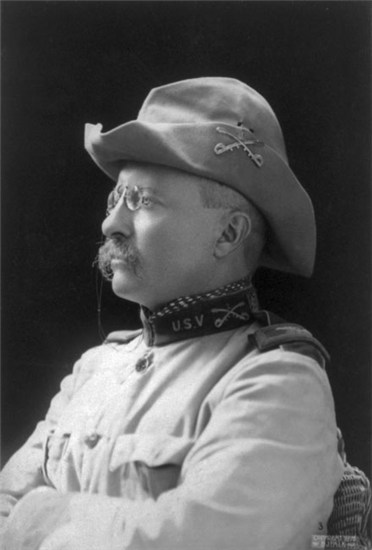
Theodore Roosevelt |
Take into consideration the various stereotypes discussed earlier and it's easy to see where the disparity arose. Roosevelt was considered one of the "manliest" men of his day, yet he very proudly wore a symbol considered anything but "manly" (Roosevelt's rimless pince-nez are visible in his Presidential portrait as well as the numerous photos taken of his over his life). The American people, then, were forced to reconsider their attitude towards glasses: if Theodore Roosevelt wore glasses, did that mean they were... cool?
The answer was a resounding "yes." Concurrent with Roosevelt's presidency, the people of America began to cautiously approach glasses as something that perhaps didn't symbolize all of the things they'd previously believed.
As with today's fashion trends, emulation of the famous was the name of the game. Since Roosevelt's glasses had inspired the turnaround in outlook on eyewear, rimless was the name of the game. Fortunately, for all concerned, an exciting new development had taken place. Owing to the waning popularity of pince-nez (brought about in large part by the rise in astigmatism diagnoses), opticians eager to seize on rimless pince-nez's popularity had mounted temples to the lateral sides of the lenses. Thus, the first three-piece glasses were born.
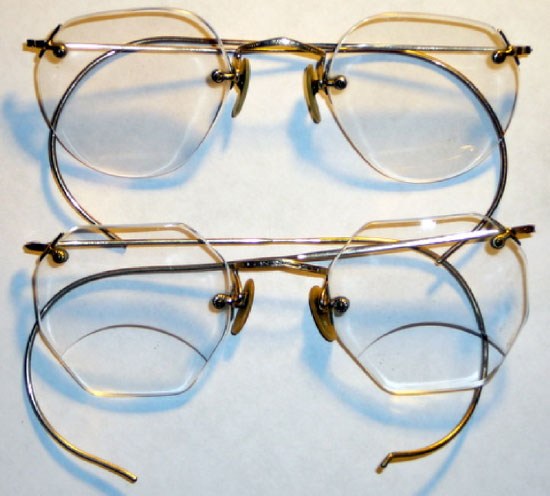
3 Piece Mounting |
Although Roosevelt was out of office by 1909, rimless glasses stuck around. The invention of the nosepad in the 1920s only bolstered their popularity, adding comfort while still allowing the glasses to remain lighter-weight than glasses with a complete rim. The lack of a frame also meant wearers could customize their lens shape, adding an extra degree of personalization and making them ideal for men and women.
From the 1920s through the early 1940s, rimless glasses dominated both Americans' faces and the optical world. Numerous developments arose as opticians attempted to compete with one another to create the perfect pair of rimless glasses. Perhaps the most groundbreaking of these developments was the attachment of a small "brace" to the bridge and temples of the frames, providing extra structural stability to the frame and helping to prevent breakage. While the earliest of these glasses—commonly known as "Rimways"—were held in place with two screws at the bridge and two screws at the temples. Many people believed the presence of the screws were unappealing or "ugly," and some even claiming they inhibited their peripheral vision. This resulted in the invention of "Numont" glasses, with only two screws mounted to the bridge holding the lenses in place.
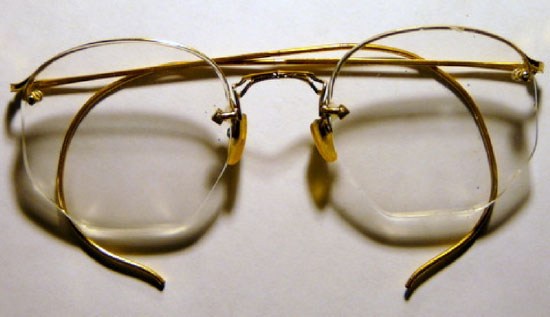
Rimway |
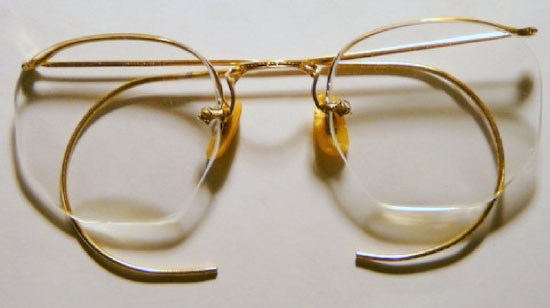
Numont |
In the realm of fashion, rimless glasses had quite a shelf life as the number one choice in eyewear: Three-piece mountings remained popular from the 1900s into the late 20s, while Rimways and Numonts dominated until the late 1940s. Despite their waning popularity, though, rimless glasses never really completely went away, and remained an acceptable alternative to bolder styles through the intervening decades.
With the implementation of titanium as an eyeglass frame material, rimless glasses were poised to make a comeback as the frame of choice for those who wanted the lightest-weight glasses possible. In the 1990s and early 2000s, rimless staged a comeback of epic proportions, as various designers introduced new mounting techniques to make their model the sleekest and lightest possible (and many lines even offering classic screw mountings for those concerned with maximum durability). Even in today's plastics-driven market, rimless glasses have rallied for yet another comeback. In an instance of history repeating itself, rimless glasses have once again become popular thanks to their being favored by popular figures, including Sarah Palin and Steve Jobs (whose round-lens, saddle-bridged frames became iconic in the wake of his death and resulted in a worldwide sell-out of rimless frames at optical trade shows).

Steve Jobs |
While the future of eyeglass trends may be largely uncertain, one thing can be counted on: no matter how popular they are, rimless glasses are–and always will be–in style.













